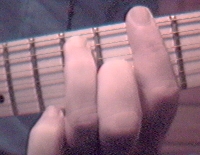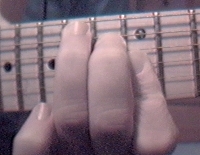Scroll through the lesson and click on notation/video/audio links to load the interactive players.
Please subscribe to get full access to all lessons for only $7.95/month PLUS 1 week free trial.

Riff Interactive lessons are
LESS expensive and
MORE interactive than alternatives!
More Info
|
|
| Lesson Subject:
Brian Setzer Style |
| What you learn:
Lesson 1 |
| Teacher:
Rusty Cash |
Lesson Example
Looping Jam
Track
Introduction
Brian Setzer is best known as the wild front man/guitarist for the band
"Stray Cats" and more recently "The Brian Setzer Orchestra". Over the last 20
years he has continued to keep Rockabilly alive while maintaining the same
energy that is essential within this style of music.
Rockabilly is a melting pot of several different types of music. The most
obvious will be rock, country, and swing. From there you can go deeper into the
roots of blues, jazz, etc.
The Stray Cats were formed in the early eighties. They were a 3-piece band
that flat out rocked. I remember being a kid, way before MTV, CMT , and VH1. I'd
stay up at night watching a special HBO hosted, called "HBO Jukebox". They
always played "Stray Cat Strut" and a few other good videos.
As other styles of music came and went, Brian Setzer seemed to be one of a
few that has survived doing exactly what he did in his earlier days. Point
being, the main thing that makes this music cool, fun to play, and allows it to
last, can't be taught. It's all about attitude, having fun, swingin' and pushing
the limits.
Tone
Rusty:
We'll start by talking a little about Brian's tone. Brian uses a signature series Gretcsh
through a Tone Master, one of Fender's custom shop amps. He uses some old stomp
box effects for delay etc. For this lesson and all of the other
ones I teach, I've used the same G&L ASAT Classic through a compressor. From there I've plugged into a JD Morley preamp that gives me the amp emulation
and distortion.
Rusty: The big difference between my tone and
Brian's will be that he uses an archtop guitar while I use a solidbody. Listen to his music and after awhile you can hear the difference between the two
guitars. I'll have to break this lesson up into
two segments because of it's length and variations. The whole song has 4 different parts.
PART 1
Rusty: Part
1 is a "Travis Style" fingerpicking pattern that Brian commonly uses. This part
begins with a turnaround in E. The chords are:
B7 / A7 / E7 / B+5 (or
augmented)
B7, 7th fret

A7, 5th fret

E7, 7th fret

B+5 (augmented), 14th fret

Rusty: We will use a variation of the
same turnaround throughout the whole
song.
Rhythm
Alternate Picking
Rusty: Hopefully video will clear up
any questions concerning which fingers I use. There are several ways you could
play this lick and even change it. Notice I hold the chords while playing
the melody licks around that position. All we are doing is emphasizing the
dominant (b7) voicing while picking a 1 - 5 bass line typical of the country
"Travis Picking or Chet Atkins Style".
_rhythm alternate picking right hand
Rusty: Look at the second video that
was slowed down. There, I use a pick which is probably
how you'll want to play with this song. For the alternating bass I use the pick
or if you stick to your fingers use your thumb.
Rusty: On the higher melody licks I alternate
between the middle and third
finger. If you use your thumb you could use your
index and middle finger. I keep that same pattern
throughout the whole lick. What throws you off is the
triplet inside the lick. But if you'll stick to one
of those formulas you should get it.
PART
2
Rusty: Before we cover
another part let's look at the E minor blues scale. I use this scale a lot over
the licks.
Rusty:
Here is the E relative minor in that position.
Rusty:
When we combine the two together we have a combination of 8 notes. We'll use
these two scales throughout the song. PART 2
is based off of a diminished voicing that come from the E minor blues
scale.
E Diminished

Rusty: Diminished chords will repeat every 3
frets. In our example we use four different voicings that will take up one bar
giving us a four bar break:
E dim / G
dim / Bb dim / C# dim
_rhythm
Rusty: PART 2 is a break that plays the diminished chord 4 times. As a lick we play an arpeggio that goes along with it.
_diminished
lick
Rusty: This does a lot for this section. I'm using
it in an aural sense. I'm letting you know I'm about to take off and jam over
the first time through. I use it again the second time which
does the totally opposite by breaking down into something totally different.
Also on the second time through I have two other guitars harmonizing. That is done intentionally because the whole idea comes from a horn section,
where you might have several people
playing. We'll cover more about diminished chords
and where to use them because Brian adds them in all through his playing.
PART
3
Rusty: The third part is a standard
blues progression in E that has two variations in the turnaround. The progression
is:Variation 1
E / E / E / E
A / A / E / E
B / A / E / G dim - F# dim
Variation 2
E / E / E / E
A / A / E / E
B / A / E / B7
Rusty: I'm sending
you the turnaround tab for variation 2.
_rhythm part 3
Rusty:
Here's a video that goes through the whole chord progression and the
tabbed out turnaround. You'll use the same "boogie rhythm" for
the rest of the song. This will be the part that we will build
our solo licks over. For the licks I've mainly use the blues scale and I
threw in some country stuff but we'll break them up individually.
LICKS
_lick1
Rusty: Lick 1 - Is an open string
blues lick that repeats for the first 8 bars. You'll want to play these licks
with a loose feeling. Most of this lick is up and down strokes with the pick.
Don't worry about extra noise from other strings. Just dig in and play hard. You
might want to hybrid pick the open note on the second string - meaning use your
middle finger to grab that note.
_lick1a
Rusty: Lick 1a - The turnaround lick is built off of the blues scale and it
highlights the diminished chords used over the last
bar.
_lick2
Rusty: Lick 2
- Follows the same idea as lick 1 but has a major quality because
I'm playing the major 3rd at the 16th fret. We start by sliding in from two frets
back at the 10th fret. This helps emphasize the b7 of E which is D giving our
lick a dominant sound.
_lick2a
Rusty:
Lick 2a
on the turnaround we use the
second variation. Our lick follows the chord changes using a common double stop
lick that can be found in rock, country, and blues. This lick also emphasizes
the dominant quality of the chords. The last bar uses the diminished
idea at the 15th fret while our rhythm resolves on the V chord (B). Just to show you that
those two can work together.
Rusty: Rhythm 4 is something "off the wall" that I
thought sounded cool. It breaks the song down using some different ideas based
over the key of E. The progression is different and is really has more of a
Ragtime quality than anything. Although I didn't play it this way, by
fingerpicking you could put the two parts together. The 3rd guitar is something
that is supposed to be like a violin in the background. It's something to raise
the eyebrows so people can ask "what is that?"
_rhythm part 4
Rusty: The chord progression for this part
is:
E / D# dim b7 / C# min 7 / C
7
E / D# dim b7 / C# min 7 / C
7
Lick 3
Rusty: Over this lick we're highlight the
(b7) again for each chord. What makes this different sounding is the backing
chords. When we get to the D#dimb7, we play the same lick that will work over
the A7 and it may be easier if you look at that lick built of the A7. The
last part has a swing lick in E. That lick could stand alone as an ending.
Within in it you have a diminished arpeggio leading in to some chromatic notes
that bounce into the major 7 of E. You could think of it as a bebop
lick.
Lick 3a
Rusty: We're still playing over the same progression except over the E instead of emphasizing the dominant 7 like in lick
1, we play a minor lick adding in the major 7 (Eb) as a passing tone. That idea
will come into play in later lessons when we look at some minor chord
progressions and use the harmonic minor scale. The rest of the lick is like the
first one except we just hang it out there where the surf lick begins. Lesson 2
will be a continuation of this lesson.
|
<< load notation from left
|
|
<< load audio from left
|
<< load audio from left
|